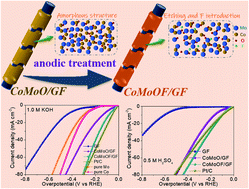Design of an amorphous and defect-rich CoMoOF layer as a pH-universal catalyst for the hydrogen evolution reaction†
Abstract
Herein, a brief structural design strategy is proposed to fabricate amorphous CoMo bimetallic oxyfluoride on graphite felt (CoMoOF/GF) for efficient hydrogen evolution reaction (HER). Porous and defective CoMoO/GF is employed as a structure-induced template to induce the formation of CoMoOF/GF with more rich defects and a larger pore structure via proper anodic treatment. Theoretical calculations reveal a synergistic catalytic effect stemming from the CoMo bimetallic components, endowing CoMoOF/GF with more favorable HER performance. The amorphous construction endows the catalyst with remarkable mass transfer ability and sufficient exposed atoms, enhancing the electrochemically active surface area (ECSA). CoMoOF/GF with structural advantages and the synergistic effect of bimetallic components displays a considerably low overpotential of 79 mV at η10 and a Tafel slope of 43.3 mV dec−1 for the HER in alkaline medium. Furthermore, excellent activity with an overpotential of 94 mV at η10 and a Tafel slope of 60.2 mV dec−1 is observed in acidic medium as well. Besides, long-term stability is achieved within CoMoOF/GF when operating at −200 mV for 100 h.



 Please wait while we load your content...
Please wait while we load your content...